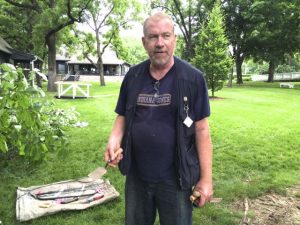Links to web resources provided by Dr Michael Fuller

Dr. Michael Fuller speaking to the high school students on the first day of the archaeological dig at Sappington House, Summer 2016.
Dr. Michael Fuller initiated the archaeological dig at Sappington House. As the head of the education committee for the Archaeological Institute of America(AIA) St. Louis Society, and professor of archaeology at St. Louis Community College Meramac campus, Dr. Fuller had planned and supervised quite a number of archaeological field schools. He laid out the program for students at Sappington House and it was implemented by the Sappington House, the City of Crestwood, and the Sappington-Concord Historical Society.
Dr. Fuller supplied the following links to the students and organizer of the student archaeological dig at Sappington house. He called this group of web pages, “Frontier and Historic Sites.” It also includes reviews of other archaeological digs that he organized or worked on.
The following group of web sites review archaeological digs Dr. Fuller supervised or in which he participated. These are public reports on archaeological digs that may in some ways be similar to the archaeological dig at Sappington House. The reports are rich in photos. The commentary gives a sense of what archaeological digs are about, how they are done and why they are done. There is also reference to conclusions made, the results of the digs.
http://users.stlcc.edu/mfuller/sappington.html
http://users.stlcc.edu/mfuller/laclede.html
http://users.stlcc.edu/mfuller/ponyexpress.htm
http://users.stlcc.edu/mfuller/quinettecemetery.html
http://users.stlcc.edu/mfuller/StateCapitol.html
Advice to students thinking about further studies in archaeology and lists are archaeological fiend schools
http://users.stlcc.edu/mfuller/StLouisTrails.html – A survey by Dr Michael Fuller of Native American trails in the St Louis area, “a contribution to The Mounds – America’s First Cities Feasibility Study Draft.”
http://users.stlcc.edu/Mfuller/THORNHILL/Thornhill.html – Report on archaeological excavations at the Thornhill historic site.
http://users.stlcc.edu/mfuller/trailoftears2011.html – A field survey of the Natchitoches Trace (also called the Old Spanish road) which passed through Wayne County, Missouri. “Historic records indicate that this was the route used by the Cherokees and their enslaved Africans during the Trail of Tears.”
http://users.stlcc.edu/mfuller/girlsinc/whitehaven/whitehaven.html – A report on a series of archaeological excavations done at the Ulysses S. Grant National Historic Site (called Whitehaven) in St. Louis, Missouri which was the nineteenth century home of Grant and his wife, Julia Dent Grant.
http://users.stlcc.edu/mfuller/arrowrockschool.html – Photos of 1980 archaeological dig in Arrowrock, MO, “Arrowrock First Schoolhouse”
http://users.stlcc.edu/mfuller/booneslick.htm – Boone’s Lick State Historic Site in Howard County, Missouri. “The saline water was processed at the site by Native Americans before the arrival of the pioneers.”
http://users.stlcc.edu/mfuller/lempdig/Lemp.html – Lemp Avenue (addresses 3314-3318) Archaeological Site – Discovering the Underground Railroad in St. Louis Discusses whether there was slavery in St Louis.
http://users.stlcc.edu/mfuller/robidouxrow.html – Archaeological excavation at the historic site of Robidoux Row on brick building built by Joseph Robidoux I, founder of St. Joseph
